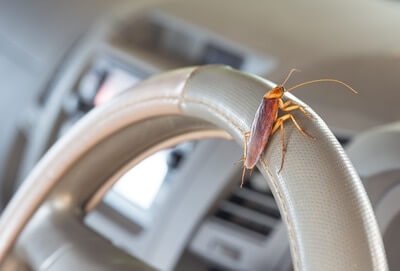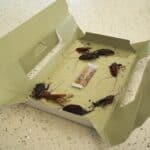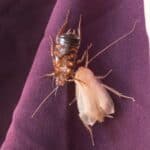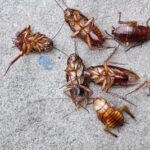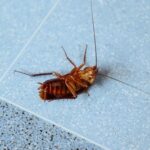Cockroaches not only live in cars, but they can thrive in this environment. They will quickly find hiding spots, eat food crumbs, and multiply in number quickly.
The favorite place for cockroaches to hide in a car is under the seats due to the morsels of food that can fall under there. Other areas that conceal roaches are the glove compartment, center console, doors, and trunk. You may find roaches in the bed of your truck or camper, nestled in with trash or bedding.
Roaches can thrive in cold or hot cars. As long as the temperature doesn’t exceed 120 degrees or drop below 15 degrees, they will be fine. The best ways to remove roaches are with natural pesticides, such as Diatomaceous earth and boric acid. You can also use gel baits and natural deterrents, but be careful when using anything stronger.
Where Do Roaches Hide in Your Car?
Roaches are nimble and small, and cars have many hiding spaces. They will climb into:
- Door interiors
- Under seats
- Under floor mats
- Seat cushions
Any area that is dark and provides warmth is ideal for roaches to hide. That’s also true for any space that offers a food source or food waste. The garbage found in cars or trucks is perfect for roaches to find a meal.
If your car has a bed, such as with campers, it will also be a prime target for roaches. Leftover food wrappers, blankets, and pillows will be an ideal haven for these resilient bugs.
Where Do Cockroaches Hide in Cars During the Day?
As cockroaches are nocturnal insects, they will hide in dark areas during the day and appear in the evening. When cockroaches are in your car, they will hide just about anywhere; these areas will include:
- Under car seats
- Glove compartment
- Center console
- Under blankets and clothes in the trunk of a car
- Boxes and bags in the car
- In the door panel
- In the speakers
- In the air conditioning unit
The list goes on, but cockroaches will survive where a food source is within reach. They will even reproduce if they have ideal conditions. A few cockroaches will turn into an infestation quickly.
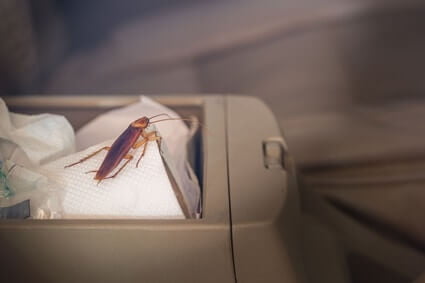
Where Do Cockroaches Hide in Garages?
If you have an infestation, you probably wonder where they came from in the first place. Sadly, garages can be a breeding ground for cockroaches because they have many hiding places. The entire area is full of dark, warm, moist areas for them to take up residence. Cockroaches look for in a habitat in:
- Boxes
- Cupboards
- Bags
- Cluttered areas
If you park your car in the garage each night, the chances are that’s when the roaches will make their move. If you leave a window open or even the door or trunk while unloading, they may take advantage.
When you finally decide to clean out the garage, the boxes or bags you transport in your car may contain cockroaches. They will then move into the vehicle during transportation.
Why Do Cockroaches Hide in Car Doors?
Car doors make good hiding places for roaches. They have large open spaces that are ideal for a colony to lay eggs. The spaces are dark, warm, and, in many cases, contain moisture from the elements. The door panel will protect the roaches from extreme weather conditions and be ideal for them to hunker down and hibernate during the winter.
Likewise, there’s more food in these spots. When people eat in their car, the car door panel is a quick and easy place to store trash until the vehicle is cleaned out properly. The leftovers or crumbs are a food source that cockroaches are looking for to survive. A door panel is a place where roaches can thrive.
Why Do Cockroaches Infest Cars?
Cars can be an ideal living habitat for cockroaches. These insects prefer a warm, dark, moist area where food is readily available.
Ample Food
Many vehicle owners will leave trash in their cars for a long time, which will attract cockroaches. As well as the garbage left behind, owners will eat in their vehicles, dropping food particles:
- On the floor
- Down the side of the car seat
- The surface of the seats
The food particles are an attraction to cockroaches, who are omnivores and will eat meat and vegetables. Although cockroaches prefer meats, starches, and sweets, they will consume just about anything. This includes:
- Decaying matter
- Hair
- Paper
According to the Wiley Online Library, cockroaches use carbohydrates as their primary source of energy. Additionally, male cockroaches will eat carbs as it makes them more attractive to females.
A Familiar Environment
Roaches will also infest cars that have dark, warm areas for them to hide. With various cockroach species on every continent globally, they can survive in many different environments. However, their numbers are more concentrated in the subtropics and tropics.
The majority of roaches will live in the undergrowth, where fallen leaves and twigs lay and begin to decay. This provides them with the dark, moist, and warm environment they prefer. The interior of a car can provide many of the same living conditions that cockroaches are looking for.
How Do Roaches Get in Your Car?
There are several ways that a cockroach can get in your car. If you’re dealing with an infestation, these oversights may be the cause:
Open Windows
Some species of roach can fly, so they may fly in through an open car window or door. If you’re leaving your car parked in the garage, be sure it’s properly closed up.
Carried In On Items
As mentioned, they like warm environments, so roaches can be found in luggage, boxes, and even shopping bags. An item that you are bringing to and from your home can contain cockroaches. Unfortunately, these will have to pass through the car to reach their destination.
Through Gaps
Roaches will climb into any small openings they can find. This makes it easy for cockroaches to access your car through:
- Gaps in the door
- Holes in the windshield lining
- Cracks in your sunroof lining
- Damage or pockets in your undercarriage
How Do Roaches Get in Your Car Trunk?
Cockroaches will find many ways to get into the trunk of your car. This may include:
- In gaps along the lining. If your trunk doesn’t have a perfect seal, this could be a gap roaches manipulate.
- Transported items. The most common way is in a bag or box that you are transporting.
- Passage between your cabin and trunk. If your car has a little door leading into the cabin through the seats, roaches may travel from the interior to the trunk.
Once in the trunk, cockroaches will find an ideal area to live. After all, it’s dark, secluded, and holds groceries or trash.
Can Roaches Live in Cars?
Cockroaches can live just about anywhere, as long as they have a source of food. Roaches will thrive in your car, especially if you eat or allow others to eat in the vehicle. A small crumb from a sandwich or leftover fry is an energy source for roaches, making the car the ideal habitat.
Since cockroaches are nocturnal, a vehicle can be ideal unless they are in use. Cars tend to be completely dark inside, and they have many small openings that will lead to warm hiding spots for the roaches.
Roaches will lay eggs in several places in a car. A single female cockroach will lay anywhere from 14 to 36 eggs in one sitting. According to the Entomological Society of America, an American cockroach incubation period is 35 to 40 days, and it will take a nymph 350 days to fully mature. Perfect egg-laying places may include:
- Speakers
- Door frames
- Glove compartment
- Under the seats
- Inside the center console
Can Roaches Survive in a Hot Car?
It all depends on the exact temperature your car reaches. Most cockroaches are unable to survive temperatures exceeding 120 degrees Fahrenheit. Depending on your climate, your car can reach this temperature.
However, keep in mind that roaches aren’t likely to be sitting out in the sun on the dashboard of a car. They will be hidden in the door, under the seat, or within the speakers. The areas that the cockroaches choose to hide in will not be reaching these high temperatures due to the shade.
When it gets this hot, roaches are likely to find new hiding spaces. After all, they are far more active in the warmer months than the cold ones. Roaches will seek out cooler temperatures and more water sources. They want a location that is between 75 and 90 degrees Fahrenheit. They may flee into your garage and eventually into your home.
If a roach cannot escape a car with an internal temperature over 120 degrees, it will bake to death. If you have a serious infestation and hot summers, this may be an effective way to eradicate the problem.
Can Roaches Survive in a Cold Car?
Just like with a hot car, roaches may be killed off in a cold car. That is, as long as your car dips below freezing temperatures. The species of cockroaches found in and around human habitats, like the American cockroach, can freeze in temperatures below 32 degrees Fahrenheit.
Cockroaches are cold-blooded creatures, so they are unable to regulate their interior body temperature. However, it is known that roaches are adaptable. In some instances, they will alter their behaviors to increase their chances of survival. Cockroaches will hibernate in the winter months, entering a state known as diapause.
While in diapause, their development will come to a complete halt. Cockroaches won’t reproduce and will stop growing. They will create a nest near a food source during winter and hunker down for the season.
Roaches can be revived from this state, so freezing temperatures aren’t enough. You will need the temperatures to drop to 15 degrees and stay there. In this case, the roach will eventually die.
However, even if your garage is that cold, this temperature may not remain consistent throughout the entire car. Areas under seats and within the doors will be warmer. You also risk damaging the car itself by allowing it to stay this cold for long periods of time. Hoses, electronic parts, and seals may begin to freeze and crack.
Can You Bug Bomb Your Car for Roaches?
A favorite method for eliminating an infestation is bug bombing. A bug bomb is a fogger that releases a pesticide into the air, killing all bugs in the area that breathe it in. Can you use them in a car?
Bug bombs are not as effective as we’d like. The pesticide won’t reach all the places a roach would be hiding in, so it won’t wipe out an infestation entirely. Another downside of bug bombs is that they’re harmful to humans and pets.
Once a bug bomb has been set in your vehicle, you will need to air it out to ensure you don’t inhale any of the chemicals. Some bug bombs contain chemicals that can discolor fabric and affect the car’s materials’ lifespan.
After a bug bomb has been used, the owner will need to have the vehicle cleaned to avoid contact with the chemicals left behind. Only bug bomb your car if you:
- Don’t need to drive or stay in the vehicle for a day or two
- Don’t mind cosmetic damage to the interior
- Can have it cleaned thoroughly
The Fastest Way to Get Rid of Roaches in a Car
There are other ways to eliminate roaches. Here is how you can clean out roaches from your car:
- Clean out food. Vacuum up every morsel of food, no matter how small.
- Remove items used as hiding places. Remove anything from the car that could be used as a home. Boxes, gym bags, shopping bags, even a kids toy, if it has an opening, can be used as a roach home.
- Gel bait traps. Using gel bait traps is recommended because they attack roaches in multiple ways. They kill any roach that consumes the poison, and then kill others as the poisoned bug scurries back to the colony.
- Use boric acid. Boric acid will kill a roach if ingested. Mixing it with food particles is the only way to accomplish this.
Getting Rid of Roaches In A Car’s Air Conditioner
It may be difficult to use pesticides on an air conditioner, as this can easily blow that poison back onto you. As such, if you have roaches in the AC unit of your car, how can you safely eliminate them?
Clean
Clean out the entire vehicle. Remove what makes the environment appealing to the roaches, which is food.
Use Diatomaceous Earth Around The Unit
Roaches have to come out eventually. You can sprinkle some Diatomaceous earth around the center console and then wait. This is a natural pesticide proven to kill roaches.
A study available on Science Direct showed that Diatomaceous earth is potent as an insecticide. It can quickly reduce their numbers. Cockroaches will walk through it, and then they will take it back to their colony.

Use Deterrents
You can also sprinkle some catnip in the car. This may drive felines wild but has the opposite effect on cockroaches. Roaches find this member of the mint family to be very off-putting.
The use of boric acid is another option. When ingested, this product will kill cockroaches. To have them consume the boric acid, mix it with a food source that attracts roaches, like peanut butter.
How to Prevent Cockroaches in Cars
To prevent a roach infestation in your car, you have to ensure that the car is not appealing to them in any way. Roaches want a warm, moist, dark environment that has a food source within close reach. To prevent this:
- Stop eating food in the car. Any crumb or leftovers is an attractive roach food source.
- Limit the items you store. Make sure to remove boxes, bags, toys, or any other object that a roach can crawl inside.
- Park carefully. Be aware of where you are parking your vehicle; cockroaches are often found in garbage bins, sewage drains, and drainage openings.
- Keep the vehicle sealed. If the cockroaches have a way into the car, chances are, they will use it. Keeping windows or sunroofs closed will help prevent them from entering the car.
- Clean regularly. Vacuuming will remove any food that may have fallen down between seats or under them.
How Can You Prevent Roaches From Breeding in Your Car?
The only way to prevent cockroaches from breeding in your car is to keep them away altogether. After all, they can only reproduce en-mass if there’s enough shelter and food nearby.
Ensuring that the car is free of all food sources will stop them from breeding in your vehicle. Keep in mind that cockroaches will eat just about anything; however, they are more attracted by certain foods, which include:
- Sugar
- Grease
- Starch
- Meat
- Cheese
What Can Be Used to Keep Cockroaches Out Of Your Car?
Once the roaches have been removed, your car will be safe. As long as there’s no food to lure them in, you shouldn’t experience a re-infestation. However, that may change if you routinely place your car in a spot that has roaches.
For example, you may be unable to avoid parking your car near garbage cans. Likewise, your garage may be infested, and you’re still working to eliminate the problem.
In that case, there are deterrents you can use to make your car less appealing. These scents will help to drive off the roaches from your car.
- Peppermint
- Lavender
- Eucalyptus
- Onion powder
- Garlic
- Clovite
- Tea tree oil
- Lemon and other citrus peels
Just keep in mind that these are not 100% effective. Roaches are highly adaptable and may learn to ignore the smell if given enough time. Focus on exterminating the bugs, not annoying them.
Are Cockroaches in Your Car Dangerous?
Cockroaches can transmit bacteria that cause serious health issues. Roaches transmit pathogens and pathogenic bacteria, which will spread disease and infection.
With this evidence, we know that the surfaces within a vehicle infested with cockroaches are unsafe. As roaches move around on the car’s surfaces, they leave behind feces, body fluids, and skin castings.
Additionally, cockroaches can overrun a vehicle in a concise space of time. Cockroaches breed and multiply at a rapid rate. This can increase their number to an uncontrollable level.
If you find roaches in your car, don’t ignore them. Driving in that car may expose you to harmful illnesses. Be sure to apply some of the extermination methods discussed to remove them from your vehicle.
